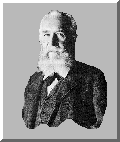Haeckel and his
Embryos
 |
Page 223 of the Lion Book (BIOLOGY - The Living Science) and page 283 of the Elephant Book (BIOLOGY by Miller and Levine) each contain drawings of the early stages of embryonic development in several vertebrates. Although neither of these drawings are identical to his, they are based on the work of Ernst Haeckel (portrait at left), a 19th century German Biologist who was a pioneer in the study of embryonic development. |
Haeckel noticed that vertebrate embryos pass through a series of similar stages in early development, and argued that there was a good reason for this. As an organism evolves, he reasoned, it does so by tacking on new stages to its process of embryonic development. Therefore, as an organism passes through embryonic development it actually re-traces every stage of its evolutionary ancestry. This idea became known as "Ontogeny recapitulates Phylogeny," which literally means "Development is a replay of Ancestry."
    |
|
|
As you read this, you may wonder why evolution should be limited to changes tacked on at the end of the process of development. So did evolutionary biologists, and Haeckel's idea was quickly discarded. In fact, evolution can affect all phases of development, removing developmental steps as well as adding them, and therefore embryology is not a strict replay of ancestry. Nonetheless, many of the stages that embryos pass through can indeed be understood as remnants of their evolutionary past. One example is the fact that the embryos of all placental mammals (including humans) form a yolk sac during their development. Why is this important? Because the eggs of these organisms do not have large amounts of stored yolk, and therefore their yolk sacs are empty! Nontheless, the persistence of a yolk sac stage makes perfect sense when one considers that these animals are descended from egg-laying reptiles in which the sac encloses a massive amount of yolk to support embryonic development |
|
|
More information on Embryonic Development:
|
|
Kenneth
R. Miller
Professor of Biology
Brown University
Providence, RI 02912
Do
you have Questions or Comments about this Issue??
Click Here to send us an e-mail
message.

